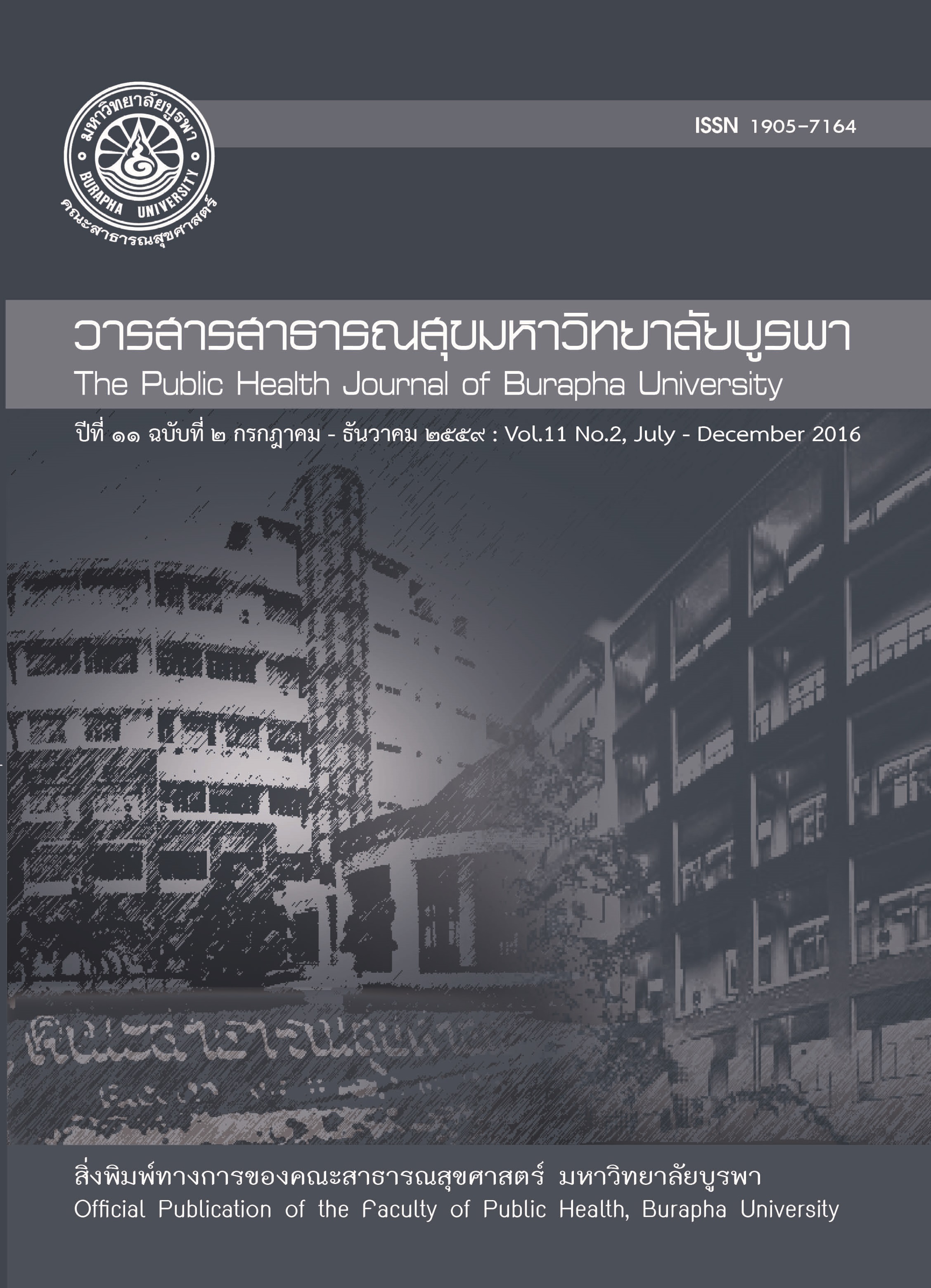The Factors Predicting Physical Activity Among Vietnamese with Type 2 Diabetes Mellitus in Hanoi, Viet Nam
Main Article Content
บทคัดย่อ
This cross-sectional analytic study aimed to explore the level of physical activity, and to predict personal characteristics, perceived susceptibility, perceived severity, perceived benefits, perceived barriers, and perceived self-efficacy on the physical activity of people with type 2 diabetes mellitus in Hanoi, Viet Nam. The study was based on the Health Belief Model1and the findings of a literature review. A stratified random sampling technique was used to select one district hospital in an urban area and the other district hospital in a rural area of Hanoi, Viet Nam. The data were collected from 110 participants in an urban area and 136 participants in a rural area using self-report questionnaires. Stepwise multiple regression analysis revealed that the mean score of physical activity was 2062.20 MET (Metabolic equivalent)-minutes per week (SD = 1168.45, range 0.00 – 5520.00), and it revealed that 11.4% of participants didn’t have enough physical activity. It also indicated that only four variables (occupation of labor, perceived susceptibility, perceived severity, and perceived self-efficacy) were significant predictors of physical activity. These variables accounted for about 20% (R2 = .20, p < .05) of the variability in physical activity. Because too few studies of these factors were conducted in type 2 diabetes mellitus in Viet Nam, further research in this field is necessary to determine if the findings of this study are consistent in this population. This study contributes scientific evidence of predictors of physical activity that can provide the basis for generating effective interventions to increase physical activity in Vietnamese people with type 2 diabetes mellitus, to control blood glucose, and to enable them to maintain their health.
Article Details
เอกสารอ้างอิง
Janz, Nancy K, Becker, HM. “The
Health Belief Model: A Decade Later”.
Health education behavior.11th ed. 1984.
doi:10.1177/109019818401100101.
Shaw JE, Sicree RA, Zimmet PZ. Global
estimates of the prevalence of diabetes
for 2010 and 2030. Diabetes Research
and Clinical Practice. 2010; 87, 4-14.
Lanh NV. The actual state of diabetes
mellitus, pre diabetes in Khermeethnic,
HauGiang province, and examine effect
of intervention. Hau Giang; 2014.
Ministry of Health of Vietnam. Annual
report. [online]. 2007. Avaiable from
http://www.moh.gov.vn/legaldoc/pages/
Directdocument.aspx. (Cited : August
, 2014).
American Diabetes Association. Standard
of medical care in diabetes. Diabetes
Care; 2014.
Binh TV, Hoan LQ. Improving the
qualityof diabetes education in Vietnam – a
community based approach. Diabetes
Voice 2007; 52: 46-48.
Chuang LM, Tsai ST, Huang BY, Tai
TY. The status of diabetes control in
Asia--a cross-sectional survey of 24 317
patients with diabetes mellitus in 1998.
Diabet Med. 2002; 19(12): 978-85.
WHO. The impact of chronic disease
in Australia. [online]. 2009. Available
from http://www.who.int/chp/chronic_
disease_report/australia.pdf. (Cited :
September 17, 2014)
American Diabetes Association. Nutrition
recommendations and intervention for
diabetes. [online]. 2011. Avaiable from:
http://care.diabetesjournals.org/
content/31/Supplement_1/S61.full.
(Cited : September 19, 2014)
Ha BT. The diabetes sistuation in
patients at General hospital in Bac Can
province. (Master thesis, Thai Nguyen
University of Medicine). [online]. 2009.
Avaiable from: http://www.tn.edu/~asb/
theses/2009/. (Cited : October 1, 2014)
Anna M, Petra P, Renate KM, Ulrike
T, Timo H. Barriers to physical activity
in older adult in Germany: a cross
sectional study. International Journal
of Behavioral Nutrition and Physical
Activity 2011; 8(121).
Ashley MF, Devin MM, Michelle AR,
Lawrence CK, Carol RH. Barriers to
physical activity in East Harlem, New
York. Journal of Obesity 2012; doi:
1155/2012/719140.
Glanz, K., Rimer, B. K., Viswanath, K.
th ed.. Health behavior education: theory,
research, and practice.San Francisco:
Jossey-Bass; 2008.
Geoff PL, Wallid EA, John KP. Perceived
exercise benefits and barriers of non-exercising female university students in The United Kingdom. International
Journal of Environmental Research and
Public Health 2010; 7: 784-98.
Ronald CP, Linda T, Kerry SC, Nandini K,
Ronald JS. Predictors of aerobic physical
activity and resistance training among
Canadian adults with type 2 diabetes: An
application of the Protection Motivation
Theory. Psychology of Sport and Exercise
; 10: 320-8.
James E, Joe W, Chadwick C. Organizational
research: Determining appropriate
sample size in survey research.
Information Technology, Learning, and
Performance Journal 2001; 19(1): 43-50.
Sechrist KR, Walker SN, Pender NJ.
Health Promotion Model - Instruments
to Measure HPM Behavioral Determinants:
Exercise Benefits/Barriers Scale
[EBBS] (Adult Version). University of
Michigan; 1987.
WHO. Global physical activity questionnaire.
Gevena, Switzerland: n.d. [online].
Avaiable from: http://www.who.int/chp/
steps. (Cited : on September 20, 2014)
Herrmann SD, Heumann KJ, Der
Ananian CA, Ainsworth BE. Validity and
reliability of the Global Physical Activity
Questionnaire. Measurement in Physical
Education and Exercise Science. 2013;
: 231-235.
Melissa B, Sara W, Marilyn L, Kimberly
B, Rickey EC, Lottie M,Anntronet
Y. Factor associated physical activity
among African-American men and
women. American Journal and Preventive
Medicine 2006; 30(4): 340-6.
Navaporn C, Nualpis I. Exercise behavior
and knowledge among the diabetes
mellitus type 2 patients. J Med Assoc
Thai 2009; 93(5).
Juma A, Fatma A, Hussein S, Bachar A,
Hasratali P, Nicolass N. Physical activity
and reported barriers to activity among
type 2 diabetic patients in the United
Arab Emirates. The review of diabetic
studies 2009; 6(4), 271-8.
Mishalia M, Omer H, Heymann AD. The
importance of measuring self-efficacy in
patients with diabetes.Family practice
; 28: 82-7.
Forsyth LH, Goetsch VL. Perceived threat
of illness and health protective behaviors
in offspring of adults with non-insulindependent
diabetes mellitus. Behavioral
Medicine 199; 23(3): 112-20.
Adam J, & Folds L. Depression, Selfefficacy,
and Adherence in Patients With
Type 2 Diabetes. The Journal for Nurse
Practitioner 2009;10(9): 646-52.
Jame AS, Hudson MA, Campbell MK.
Demographic and psychosocial correlates
of physical activity among African
Americans. Am J Health Behav 2003;
(31): 431.
Daniel M, Messer LC. Perceptions of
diasease severity and barriers to sel-care
predict glycemic control in Aboriginal
persons with type diabetes mellitus.
Chronic Dis Can 2002;23(4): 130-8.

